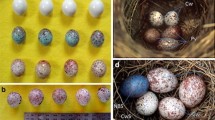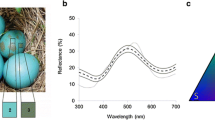Abstract
Characteristics of egg surfaces serve as recognition cues that allow avian hosts to detect and reject foreign eggs in brood parasitism. The blunt egg pole hypothesis suggests that the blunt egg pole is an essential signal in parasitic egg recognition. In the present study, eggs of Yellow-bellied Prinia (Prinia flaviventris) were painted with black spots at either the blunt or sharp egg pole to determine and compare the responses of different populations exposed to brood parasitism (parasitized population) or not (non-parasitized population). These results supported the above hypothesis and showed that the parasitized population displayed a higher rate of rejection of eggs with blunt pole-painted spots than with sharp pole-painted spots. In contrast, the non-parasitized population accepted all experimental eggs, which may be related to decreased egg recognition resulting from low exposure to brood parasitism.
Zusammenfassung
Entfernen der Eier von Brutparasiten durch Gelbbauchprinien: Die Bedeutung der Position von Pigmentflecken
Merkmale von Eioberflächen dienen als Erkennungssignale, die es Wirtsvögeln ermöglichen, im Fall von Brutparasitismus fremde Eier zu erkennen und zu entfernen. Die „stumpfer Eipol“ Hypothese schlägt vor, dass der stumpfe Eipol ein entscheidendes Signal für das Erkennen der Eier von Brutparasiten darstellt. In der vorliegenden Studie haben wir die Eier von Gelbbauchprinien (Prinia flaviventris) mit schwarzen Punkten bemalt, entweder am stumpfen oder am spitzen Eipol, um die Antworten der Vögel in parasitierten und nicht parasitierten Populationen zu ermitteln und vergleichen. Unsere Ergebnisse stützten die obengenannte Hypothese und zeigten, dass Gelbbauchprinien in der parasitierte Population Eier, bei denen die Flecken auf den stumpfen Eipol gemalt wurden, mit höherer Wahrscheinlichkeit entfernten als Eier mit am spitzen Eipol aufgemalten Flecken. Im Gegensatz dazu wurden in der nicht parasitierten Population alle experimentellen Eier akzeptiert, was mit verminderter Eierkennung infolge geringer Brutparasitismusgefahr zusammenhängen könnte.



Similar content being viewed by others
References
Avilés JM, Møller AP (2004) How is host egg mimicry maintained in the cuckoo (Cuculus canorus). Biol J Linn Soc 82:57–68
Avilés JM, Soler JJ, Pérez-Contreras T (2006) Dark nests and egg colour in birds: a possible functional role of ultraviolet reflectance in egg detectability. Proc R Soc Lond B 273:2821–2829
Bennett ATD, Cuthill IC, Partridge JC, Maier EJ (1996) Ultraviolet vision and mate choice in zebra finches. Nature 380:433–435
Bowmaker JK, Heath LA, Wilkie SE, Hunt DM (1997) Visual pigments and oil droplets from six classes of photoreceptor in the retinas of birds. Vis Res 37:2183–2194
Chen K, Liu L, Fan F (2000) The changes of Taiwan Island. J Tianjin Normal Univ 20:59–63
Cherry MI, Bennett ATD (2001) Egg colour matching in an African cuckoo, as revealed by ultraviolet visible reflectance spectrophotometry. Proc R Soc Lond B 268:565–571
Cherry MI, Bennett ATD, Moskát C (2007) Host intra-clutch variation, cuckoo egg matching and egg rejection by great reed warblers. Naturwissenschaften 94:441–447
Cuthill IC, Partridge JC, Bennett ATD, Church SC, Hart NS, Hunt S (2000) Ultraviolet vision in birds. Adv Study Behav 29:159–214
Davies NB (2000) Cuckoos, cowbirds and other cheats. T & A. D, Poyser, London
Davies NB (2011) Cuckoo adaptations: trickery and tuning. J Zool 284:1–14
Davies NB, deL Brooke M (1989a) An experimental study of co-evolution between the cuckoo Cuculus canorus, and its hosts. I. Host egg discrimination. J Anim Ecol 58:207–224
Davies NB, deL Brooke M (1989b) An experimental study of co-evolution between the cuckoo, Cuculus canorus, and its hosts. II. Host egg markings, chick discrimination and general discussion. J Anim Ecol 58:225–236
Dawkins R, Krebs JR (1979) Arms races between and within species. Proc R Soc Lond B 205:489–511
Ding Z, Yuan L, Zhu C, Huang J, Zheng X, Guo X, Lin J, Hu H, Tang S (2008) Nesting characteristics of yellow-bellied prinia, Prinia flaviventris. Zool Res 29:270–276
Feeney WE, Welbergen JA, Langmore NE (2014) Advances in the study of coevolution between avian brood parasites and their hosts. Annu Rev Ecol Evol System 45:227–246
Honza M, Polaciková L (2008) Experimental reduction of ultraviolet wavelength reflected from parasitic eggs affects rejection behaviour in the blackcap Sylvia atricapilla. J Exp Biol 211:2519–2523
Honza M, Polaciková L, Procházka P (2007) Ultraviolet and green parts of the colour spectrum affect egg rejection in the song thrush (Turdus philomelos). Biol J Linn Soc 92:269–276
Kilner RM (2006) The evolution of egg colour and patterning in birds. Biol Rev 81:383–406
Lack D (1968) Ecological adaptations for breeding in birds. Methuen, London
Lahti DC, Lahti AR (2002) How precise is egg discrimination in weaverbirds? Anim Behav 63:1135–1142
Lindholm AK, Thomas RJ (2000) Differences between populations of reed warblers in defences against brood parasitism. Behaviour 137:25–42
Liu J, Yang C, Yu J, Wang H, Liang W (2019) Egg recognition in cinereous tits (Parus cinereus): eggshell spots matter. Avian Res 10:37
López-de-Hierro MDG, Moreno-Rueda G (2010) Egg-spot pattern rather than egg colour affects conspecific egg rejection in the house sparrow (Passer domesticus). Behav Ecol Sociobiol 64:317–324
Marchetti K (2000) Egg rejection in a passerine bird: size does matter. Anim Behav 59:877–883
Moksnes A, Røskaft E, Braa AT (1991) Rejection behavior by common cuckoo hosts towards artificial brood parasite eggs. Auk 108:348–354
Moskát C, Avilés JM, Bán M, Hargitai R, Zölei A (2008a) Experimental support for the use of egg uniformity in parasite egg discrimination by cuckoo hosts. Behav Ecol Sociobiol 62:1885–1890
Moskát C, Székely T, Cuthill IC, Kisbenedek T (2008b) Hosts’ responses to parasitic eggs: which cues elicit hosts’ egg discrimination? Ethology 114:186–194
Moskát C, Bán M, Székely T (2010) Discordancy or template-based recognition? Dissecting the cognitive basis of the rejection of foreign eggs in hosts of avian brood parasites. J Exp Biol 213:1976–1983
Øien IJ, Moksnes A, Røskaft E (1995) Evolution of variation in egg color and marking pattern in European passerines: adaptations in a coevolutionary arms race with the cuckoo Cuculus canorus. Behav Ecol 6:166–174
Polačiková L, Grim T (2010) Blunt egg pole holds cues for alien egg discrimination: experimental evidence. J Avian Biol 41:111–116
Polačiková L, Honza M, Procházka P, Topercer J, Stokke BG (2007) Colour characteristics of the blunt egg pole: cues for recognition of parasitic eggs as revealed by reflectance spectrophotometry. Anim Behav 74:419–427
Polačiková L, Porcházka P, Cherry MI, Honza M (2009) Choosing suitable hosts: common cuckoos Cuculus canorus parasitize great reed warblers Acrocephalus arundinaceus of high quality. Evol Ecol 23:879–891
Polačiková L, Stokke BG, Procházka P, Honza M, Moksnes A, Røskaft E (2010) The role of blunt egg pole characteristics for recognition of eggs in the song thrush (Turdus philomelos). Behaviour 147:465–478
Rothstein SI (1982) Mechanisms of avian egg recognition: which egg parameters elicit responses by rejecter species? Behav Ecol Sociobiol 11:229–239
Sealy SG, Underwood TJ (2012) Egg discrimination by hosts and obligate brood parasites: a historical perspective and new synthesis. Chin Birds 3:274–294
Soler M (2014) Long-term coevolution between avian brood parasites and their hosts. Biol Rev 89:688–704
Soler JJ, Møller AP (1996) A comparative analysis of the evolution of variation in appearance of eggs of European passerines in relation to brood parasitism. Behav Ecol 7:89–94
Soler JJ, Pérez Contreras T, De Neve L, Macías Sánchez E, Møller AP, Soler M (2014) Recognizing odd smells and ejection of brood parasitic eggs: An experimental test in magpies of a novel defensive trait against brood parasitism. J Evol Biol 27:1265–1270
Spottiswoode CN, Stevens M (2010) Visual modeling shows that avian host parents use multiple visual cues in rejecting parasitic eggs. Proc Natl Acad Sci 107:8672–8676
Stokke BG, Moksnes A, Røskaft E, Rudolfsen S, Honza M (1999) Rejection of artificial cuckoo (Cuculus canorus) eggs in relation to variation in egg appearance among reed warblers (Acrocephalus scirpaceus). Proc R Soc Lond B 266:1483–1488
Stokke BG, Moksnes A, Røskaft E (2002) Obligate brood parasites as selective agents for evolution of egg appearance in passerine birds. Evolution 56:199–205
Stokke BG, Takasu F, Moksnes A, Røskaft E (2007) The importance of clutch characteristics and learning for anti-parasite adaptations in hosts of avian brood parasites. Evolution 61:2212–2228
Stokke BG, Hafstad I, Rudolfsen G, Moksnes A, Møller AP, Røskaft E, Soler M (2008) Predictors of resistance to brood parasitism within and among reed warbler populations. Behav Ecol 19:612–620
Swynnerton CFM (1916) On the coloration of the mouths and eggs of birds. II. On the coloration of eggs. Ibis 4:529–606
Takasu F (2003) Co-evolutionary dynamics of egg appearance in avian brood parasitism. Evol Ecol Res 5:345–362
Underwood TJ, Sealy SG (2006) Influence of shape on egg discrimination in American robins and gray catbirds. Ethology 112:164–173
Wang L, Liang W, Yang C, Cheng S-J, Hsu Y-C, Lu X (2016) Egg rejection and clutch phenotype variation in the plain prinia Prinia inornata. J Avian Biol 47:788–794
Yang C, Liang W, Cai Y, Shi S, Takasu F, Møller AP, Antonov A, Fossøy F, Moksnes A, Røskaft E, Stokke BG (2010) Coevolution in action: disruptive selection on egg colour in an avian brood parasite and its host. PLoS ONE 5:e10816
Yang C, Liang W, Antonov A, Cai Y, Stokke BG, Fossøy F, Moksnes A, Røskaft E (2012) Diversity of parasitic cuckoos and their hosts in China. Chin Bird 3:9–32
Yang C, Wang L, Hsu Y-C, Antonov A, Moksnes A, Røskaft E, Liang W, Stokke BG (2013) UV reflectance as a cue in egg discrimination in two prinia species exploited differently by brood parasites in Taiwan. Ibis 155:571–575
Yang C, Wang L, Cheng S-J, Hsu Y-C, Liang W, Møller AP (2014) Nest defenses and egg recognition of yellow-bellied prinia against cuckoo parasitism. Naturwissenschaften 101:727–734
Yang C, Hu Y, Ma M, Liang W, Møller AP (2015a) Absence of egg rejection in an Asian population of house sparrow (Passer domesticus), a conspecific brood parasite in Europe. Behav Ecol Sociobiol 69:723–727
Yang C, Liu Y, Liang W (2015b) Egg trait variation in a large hawk-cuckoo (Hierococcyx sparverioides) host population of Chinese babax (Babax lanceolatus). Int Zool 10:295–301
Yeung CK, Lin RC, Lei F, Robson C, Hung LM, Liang W, Zhou F, Han L, Li SH, Yang X (2011) Beyond a morphological paradox: complicated phylogenetic relationships of the parrotbills (Paradoxornithidae, Aves). Mol Phylogenet Evol 61:192–202
Acknowledgements
The authors would like to thank Canchao Yang for help with spectral data analysis, Christine Watts for improving the English proofreading, Ian Will from the University of California, Berkeley, USA, and Aiwu Jiang, Qiuli Huang, Demeng Jiang, and Yungao Hu for their assistance with fieldwork in Guangxi and Shun-Jen Cheng in Taiwan. This work was supported by the National Natural Science Foundation of China (nos. 31660617 and 31960105 to LW, 31772453 and 31970427 to WL), Initial Fund Key Laboratories of Guizhou Province (no. 2011-4005), and Joint Fund of the National Natural Science Foundation of China and Karst Science Research Center of Guizhou Province (no. U1812401).
Author information
Authors and Affiliations
Corresponding author
Ethics declarations
Ethical standards
The studies reported in this paper conformed to the laws in the countries in which they were performed. Experimental procedures were conducted in agreement with the Animal Research Ethics Committee of Hainan Provincial Education Centre for Ecology and Environment, Hainan Normal University (No. HNECEE-2011-005).
Conflict of interest
There are no competing conflicts to declare.
Additional information
Communicated by S. Bouwhuis.
Publisher's Note
Springer Nature remains neutral with regard to jurisdictional claims in published maps and institutional affiliations.
Electronic supplementary material
Below is the link to the electronic supplementary material.
Rights and permissions
About this article
Cite this article
Wang, L., Hsu, YC. & Liang, W. Rejection of parasitic eggs by Yellow-bellied Prinias: importance of egg spot location. J Ornithol 161, 987–994 (2020). https://doi.org/10.1007/s10336-020-01789-2
Received:
Revised:
Accepted:
Published:
Issue Date:
DOI: https://doi.org/10.1007/s10336-020-01789-2




